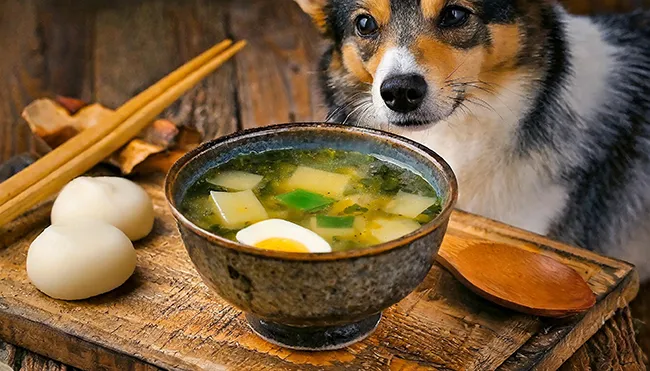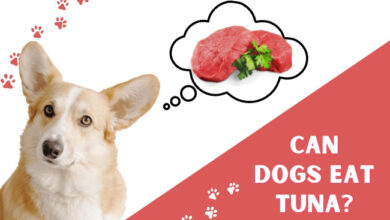
Ever caught your furry friend eyeing your bowl of miso soup with those big, pleading eyes and wondered, ‘can dogs eat miso soup?’ You’re not alone. As dog owners, we often share our lives, homes, and sometimes, our meals with our beloved pets. But when it comes to sharing our favorite dishes, it’s crucial to pause and consider what’s safe for them. Today, let’s dive into the savory world of miso soup and uncover whether this delicious human comfort food belongs in your dog’s diet. Grab your spoon, and let’s get to the bottom of this bowl together!
Understanding Miso Soup’s Nutritional Content
Miso, the heart of this soup, is a fermented food rich in vitamins, minerals, and probiotics. For humans, it’s a nutritional powerhouse, promoting gut health and bolstering the immune system. However, the nutritional lens shifts when we consider our pets.
Can Dogs Eat Miso Soup?

In short, it’s not recommended to feed dogs miso soup due to its high sodium content and the presence of potentially toxic ingredients like onions and garlic. The complex combination of ingredients and seasonings in miso soup can pose health risks to dogs, making it safer to avoid giving this human food to your canine friend.
Miso soup, as a whole, encompasses various ingredients and seasonings that make it a complex dish. While miso paste itself is fermented soybeans, which could potentially offer some nutritional benefits such as probiotics, the other components of miso soup introduce factors that might not be safe for dogs.
Here’s a breakdown of why the complexity of miso soup warrants caution:
- Sodium Content: Miso paste is high in sodium. Dogs have a lower tolerance for salt compared to humans. Consuming high-sodium foods can lead to dehydration, sodium ion poisoning, and other health issues in dogs. The broth of miso soup, rich in miso paste, can significantly exceed a dog’s daily sodium intake allowance.
- Seasonings and Ingredients: Miso soup often contains seasonings like onions and garlic, as well as other ingredients that are harmful to dogs. Onions and garlic are toxic to dogs and can cause gastrointestinal irritation and potentially lead to red blood cell damage. The effects of such ingredients are not always immediate, so even small amounts can be harmful over time.
- Nutritional Balance: Dogs require a carefully balanced diet tailored to their specific nutritional needs. Human foods, including miso soup, can disrupt this balance, especially if given regularly or in large amounts. The nutritional profile of miso soup does not align with what dogs need for a healthy diet.
- Individual Ingredients vs. The Whole Dish: While some individual ingredients in miso soup might not be harmful in isolation, the combination and quantities used in the soup as a whole can pose risks. For instance, tofu and certain vegetables might be safe for dogs in moderation, but when mixed into a high-sodium, richly seasoned broth, the potential for dietary upset increases.
Therefore, the question of whether dogs can eat miso soup is not just about analyzing the safety of miso paste but involves considering the entirety of the dish, with its complex blend of ingredients and seasonings. Given these considerations, it’s generally recommended to avoid feeding miso soup to dogs to prevent any potential health risks.
Risks of Miso Soup for Dogs
The primary concern with miso soup is its high sodium content. Dogs have a much lower tolerance for salt than humans, and too much can lead to dehydration or sodium ion poisoning. Additionally, common miso soup ingredients like onions and garlic are toxic to dogs, posing a significant risk to their health. Signs of allergies or sensitivities, including gastrointestinal upset or skin reactions, also warrant caution.
Potential Benefits of Miso for Dogs
On the flip side, miso’s probiotics could potentially benefit a dog’s digestive health, much like they do for humans. However, the risks often outweigh these benefits, making it crucial to consider safer alternatives for sharing the probiotic love with your pet.
Veterinarian Insights on Dogs and Miso Soup
Veterinary professionals generally advise against feeding dogs miso soup. The consensus is that the potential health risks, primarily due to sodium and toxic ingredients, make it an unsuitable treat for dogs. If you’re ever tempted to share, it’s best to consult your vet first.
Alternatives to Miso Soup for Dogs
Fear not! There are plenty of dog-friendly alternatives that can safely satisfy your pet’s curiosity without the risks. Consider preparing homemade treats with dog-safe probiotics or opting for specially formulated dog foods that support gut health.
How to Introduce New Foods to Your Dog’s Diet
Introducing new foods to your furry friend’s menu? Think of it as a culinary adventure you both embark on, but with a dash of caution and a sprinkle of patience. Here’s a pet-parent-friendly guide to weaving new tastes into your dog’s diet, ensuring the journey is as smooth as a well-blended doggy smoothie.
Step 1: Tiny Tastes
Imagine giving your dog a teaser of a new blockbuster movie. Start with just a nibble, a tiny taste of the new food. It’s like letting them sniff a new friend – enough to intrigue but not overwhelm. This way, their tummy gets a gentle nudge rather than a full-on push into the unknown.
Step 2: Watchful Eyes
Post-taste test, it’s time to play detective. Keep an eye out for any signs that your dog’s body is giving a thumbs up or a thumbs down. This could range from an upset stomach to an itchy coat. Think of it as watching for their food review – some dishes might get a wagging tail, while others a wary look.
Step 3: Slow and Steady
If your pup’s review is raving, slowly turn up the dial on the amount of new food. Picture it as easing into a warm bath; too fast and it’s uncomfortable, but just right and it’s bliss. The goal is to let their digestive system get acquainted over time, not overnight.
Step 4: One Dish at a Time
Introducing new foods one at a time is like reading them a storybook, where each food gets its own chapter. This way, if there’s a plot twist (aka an adverse reaction), you’ll know exactly which character (food) caused it.
Step 5: Veto Power
Above all, remember that you’re the head chef in your dog’s dietary kitchen. If you’re unsure about a new ingredient or if your dog has a sensitive stomach, a quick chat with your vet can save the day. They’re like the seasoned food critic who knows all the dietary dos and don’ts.
Embarking on this dietary adventure allows your dog to explore new flavors and textures, enriching their diet while keeping their health front and center. It’s about making mealtime exciting yet safe – a culinary journey that you both can enjoy, one careful bite at a time.
Conclusion: Balancing Curiosity and Caution
While miso soup is a nourishing treat for humans, its place in a dog’s diet is best left unfilled. The risks, particularly from high sodium and potentially toxic ingredients, make it a dish better enjoyed by pet owners alone. Always prioritize your dog’s health and well-being, and when in doubt, consult your veterinarian for guidance.
FAQs
- Q: Can dogs have soy products?
- A: In moderation, some soy products are safe for dogs, but always in much smaller quantities than would be typical for humans.
- Q: What are some safe probiotic foods for dogs?
- A: Plain, unsweetened yogurt and kefir are good options, but consult your vet for recommendations tailored to your dog’s health.
Miso soup may tantalize our taste buds, but for our furry friends, it’s a dish best enjoyed from a distance. Remember, the path to a healthy dog is paved with informed dietary choices and a dash of caution.



